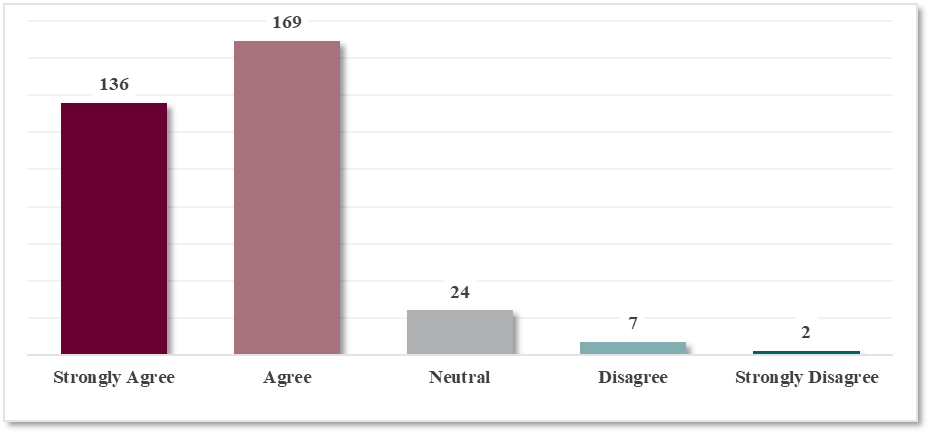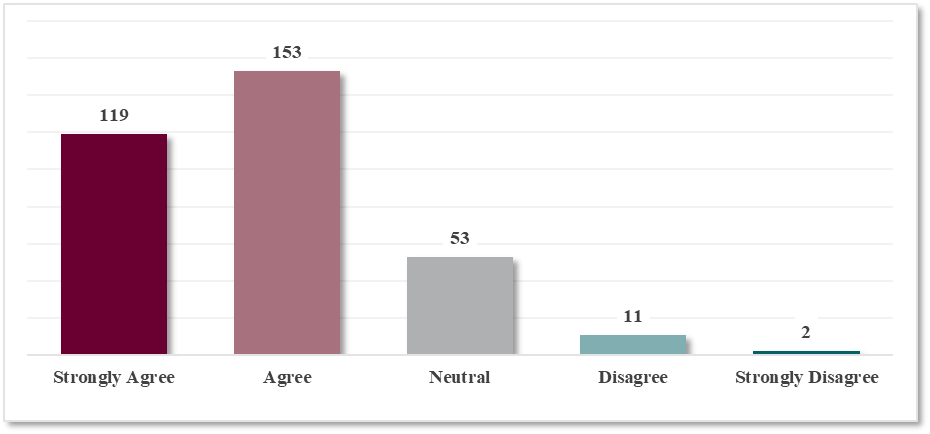1.7 Outreach and accessibility – Section 1: Conduct of the Electoral EventConduct of the Electoral Event – Returning Officers' Report of Proceedings Summary – 44th General Election
Accessibility issues
21. I resolved all accessibility issues (if any).

Text version of "21. I resolved all accessibility issues (if any)."
The bar chart shows that out of 338 ROs:
- 136 strongly agree with the statement
- 169 agree
- 24 are neutral
- 7 disagree
- 2 strongly disagree
305 ROs agreed or strongly agreed with the above statement. On the other hand, 24 were neutral, while 9 disagreed or strongly disagreed.
What went well
- The PEAs on the validation of polling places and RO/AARO offices minimized potential accessibility issues.
- The VICs clearly indicated which locations were not wheelchair accessible. When an elector needed this type of service, they could contact the RO office and be presented with alternative solutions (e.g., the option of voting by mail or at the RO office, using a transfer certificate, etc.).
What could be improved
- Further promote the usefulness of a transfer certificate to electors so that they are aware of their options.
- Reduce the number of required accessibility verifications for advance and ordinary polling places, as these are repetitive and burdensome for the central poll supervisor (CPS).
- Modify the accessibility criteria to consider the dimensions of electric wheelchairs, which are generally wider than traditional wheelchairs.
Other notable comments
- ROs in rural and semi-rural EDs reported a lack of accessible locations.
- POMs were key in managing the accessibility of polling places and RO/AARO offices.
Allocation of resources to community relations officers
22. Resources (e.g., finances, materials, time allocated, etc.) were adequate for CROs to do the required work.

Text version of "22. Resources (e.g., finances, materials, time allocated, etc.) were adequate for CROs to do the required work."
The bar chart shows that out of 338 ROs:
- 119 strongly agree with the statement
- 153 agree
- 53 are neutral
- 11 disagree
- 2 strongly disagree
272 ROs agreed or strongly agreed with the above statement. On the other hand, 53 were neutral, while 13 disagreed or strongly disagreed.
What went well
- The allocated budget allowed CROs to perform their mandated tasks. However, it is important to note that TR activities were limited, reduced or eliminated due to the COVID-19 pandemic. As a result, expenditures were lower than anticipated.
- In general, the tools and equipment provided to CROs were adequate to enable them to perform the required work.
What could be improved
- Provide more promotional materials to allow CROs to address situational challenges (i.e., to compensate for the lack of face-to-face contact with their target groups).
- Hire and deploy CROs in the field before the issue of the writ to increase the effectiveness of outreach activities. Due to the combination of pandemic-related restrictions and the short election calendar, some CROs did not have sufficient time to accomplish their tasks.
